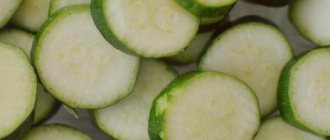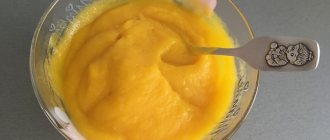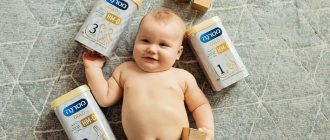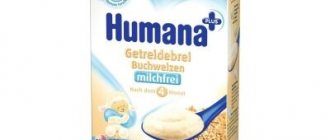Order of juice introduction
Manufacturers of children's juices always indicate on the packaging the age at which a child can be offered this product. It doesn’t matter whether you buy juice in a store or squeeze it yourself, the monthly input rates are the same.
Mono-component apple and pear juices are considered hypoallergenic and can be offered to a child for the first time.
Carrot juice is also suitable for early introduction, but for children not prone to allergic reactions.
Pumpkin and banana juice are recommended to be introduced from 8 months. Start introducing juices with one teaspoon (5 ml).
Please note that the article indicates the earliest dates for introducing juice. Juice is not a significant food product. You can postpone the introduction of juice for up to 6 months or up to a year without harming the child’s health.
Introduction of complementary foods
When an artificial baby turns three months old, some doctors believe that he can begin to be given his first food. At an early age, the baby will best digest juice, fruit or vegetable puree and kefir. Which product to choose first depends on how the baby gains weight.
Conditions for introduction
- The child must feel well and be absolutely healthy.
- No new food should be introduced on the day of vaccination.
- It is better to give unusual food in the first half of the day.
- The baby’s good mood is the key to the success of the first feeding.
- You should start with a few drops - the baby should try the new product.
- Complementary feeding is not a replacement for breast milk or adapted formula. One feeding should be completely replaced with porridge or puree much later.
- If the child is breastfed, new food is introduced 6 months after the baby is born, but if the baby is fed an artificial formula, supplementary feeding is sometimes appropriate as early as 3 months.
- Rough food should be brought to a consistency that is comfortable for the baby, since he does not yet have chewing skills at the age of 3 months.
- Fresh foods for complementary feeding are the law. Under no circumstances should you feed your baby porridge that has been in the refrigerator, rotten vegetables, or vegetables that have been sitting for a long time.
- The temperature of the new food is important. It should be neither hot nor cold. It is best if the child enjoys the taste of an unfamiliar product.
- To help your baby digest the new food better, don’t forget to give your baby drinking water throughout the day.
- Before introducing unfamiliar food, you should consult your pediatrician and get the necessary advice.
If a bottle-fed baby gains 800-900 g every month, you can try introducing juice or puree into the diet. If the pediatrician notes a lack of weight, it is better to additionally introduce kefir or porridge.
In what form is it given?
Complementary feeding for a formula-fed baby at 3 months is given to improve digestion, introduce additional microelements that the adapted formula does not contain, and to provide variety in nutrition.
- It is important to remember that the product must be prepared for better absorption by the baby. If first of all you decide to give your baby juice, then it is better to prepare it at home from natural fruits (apples, pears). Freshly squeezed juice contains much more vitamins and minerals than store-bought baby food. A few drops of the drink will allow the child to experience the taste of new food.
- Fruit puree is best prepared using a blender. Apples and pears should be baked in the oven and tried to be given to the baby on the tip of a teaspoon. You can scrape the flesh of a fresh apple.
- Vegetable puree is prepared first from one product - for example, zucchini. Later, when the baby gets used to the new diet, you can mix one vegetable with another - add broccoli or potatoes. And finally, after a couple of months, the dish should be prepared from several products: pumpkin, carrots, spinach. You should not worry if your child does not accept the first portion of vegetable puree. The baby is used to the mixture, it is sweeter, so the new unusual taste may cause him to be rejected. In order to allow the baby to adapt to the new type of feeding, it is better to mix the first dose with a drop of formula.
- Porridge is introduced into complementary foods if a bottle-fed baby does not gain the required weight. You can use ready-made food intended for baby food. But it’s better to cook the porridge yourself. To do this you will need a teaspoon of crushed rice cereal. Any other base is not advisable for the first time - many cereals contain gluten. Cereal flour should be diluted with cold water and allowed to stand. A mixture of cereal and water is poured into boiled milk and boiled until thick. To give porridge to your baby for the first time, it should be diluted with breast milk or formula. A quarter teaspoon is enough to start.
Complementary feeding table for artificial baby
We offer you a scheme for introducing complementary foods for a bottle-fed baby from 3 months to 1 year.
| Products and dishes (ml., g.) | Age (months) | |||||||||
| 0-1 | 2 | 3 | 4 | 5 | 6 | 7 | 8 | 9 | 10-12 | |
| Breast milk or infant formula | 700-800 | 800-900 | 800-900 | 800-900 | 700 | 400 | 300-400 | 350 | 200 | 200 |
| Fruit juice | 5-30 | 40-50 | 50-60 | 60 | 70 | 80 | 90-100 | |||
| Fruit puree | 5-30 | 40-50 | 50-60 | 60 | 70 | 80 | 90-100 | |||
| Cottage cheese | 10-30 | 40 | 40 | 40 | 50 | |||||
| Yolk (pcs.) | ¼ | ½ | ½ | ½ | ||||||
| Vegetable puree | 10-100 | 150 | 150 | 170 | 180 | 200 | ||||
| Porridge | 50-100 | 150 | 170 | 180 | 200 | |||||
| Meat puree | 5-30 | 50 | 60-70 | |||||||
| Whole milk, kefir and other fermented milk products | 200 | 200 | 400-600 | |||||||
| Premium wheat bread | 5 | 5 | 10 | |||||||
| Rusks, cookies | 3-5 | 5 | 5 | 10-15 | ||||||
| Vegetable oil | 1-3 | 3 | 3 | 5 | 5 | 6 | ||||
| Butter | 1-4 | 4 | 4 | 5 | 5 | |||||
Practical tips for drinking juice
- Do not let your baby drink juice from a bottle. The child drinks from the bottle slowly, which means the sugar may linger on his teeth. It's better to use a sippy cup.
- Dilute the juice with water. This will reduce the amount of sugar and help quench your thirst.
- Juice is a treat that should be given after a meal. Before eating, it may reduce your appetite.
- Packaged baby juice should not contain sugar or fructose.
- Fruit puree is healthier than juice. You can mix it with water and give it to your child as a tasty smoothie. Monitor your baby's drinking regime. Juice cannot replace water!
(46 ratings; article rating 4.5)
Share Share Share
How much and what juices to give
The first ones the baby is given to try are monojuices without pulp - apple, pear. You should start introducing juice into your baby’s diet with a standard dose - drink a teaspoon on the first day and watch the reaction. If there are no rashes or stool disturbances, then the next day you can give more and gradually increase the daily dose to 60 ml.
According to this scheme, you need to introduce each new type of juice. From 9 months to one year, a child can drink from 80 to 100 ml of juice per day.
After clarified apple and pear juice, you can give these same types of juices with pulp. Then add apricot, peach, plum, pumpkin and carrot juices.
At 10-11 months, the baby can be given multi-component berry and fruit juices - they contain more useful substances, since different fruits have their own set of vitamins and minerals. Also, before a child is one year old, it is worth introducing potentially allergenic types of juice, citrus and exotic fruit juices: orange, tangerine, pineapple, strawberry, tomato, grape, etc.
First juices for complementary feeding
The method of feeding the baby does not matter. Both on artificial feeding and on breastfeeding, it is necessary to start drinking fruit and vegetable drinks in small doses, choosing the most hypoallergenic products. Often, for starters, the baby is given juice from green apples. If you follow some rules of complementary feeding behavior, this process will go without any unpleasant surprises:
- To begin, choose a drink from one type of fruit. This tactic will help, in case of allergic reactions, to immediately determine which product should be excluded from the diet.
- It is recommended to gradually increase the number of different flavors. Add a new type of food no earlier than 7 days after the previous drink. This will also help the mother quickly identify the allergen in case of unwanted reactions.
- Self-prepared juices should not be given to a child in their pure form, since the enzymatic system of infants cannot cope with this. Freshly squeezed nectar is diluted with boiled water in a one to one ratio.
- After the first fruit drink, the first thing you should pay attention to is the baby’s stool, the frequency of regurgitation, flatulence and bowel function. If negative reactions occur, you should stop feeding and consult a doctor.
- It is not recommended to introduce a new type of drink when the baby is sick or unwell, after vaccination, or during seasonal changes.
- Give your baby a drink only after eating the main meal. Drinking juice on an empty stomach will cause irritation in the gastrointestinal tract.
Important! It is useful for children to give only fresh juices that are prepared immediately before consumption. Fruit drinks purchased in the store contain a large amount of preservatives that negatively affect a fragile body.
Proper preparation of homemade juice
There are rules for introducing juice into complementary foods for a baby:
- You can start administering it only if the baby is healthy.
Important! It is forbidden to give juice to a child during illness. You should also avoid this product if your baby has recently been vaccinated - it can cause a severe allergic reaction.
- When starting to give juice from one fruit (for example, an apple), you do not need to introduce another product at the same time. It is necessary for the baby’s body to become completely accustomed to the fruit.
- The initial portion of complementary foods is no more than 5 drops. The amount is increased daily, bringing it to several teaspoons. If the child is older, you can give a small amount of the drink from a cup or bottle.
First feeding with juice
- You cannot give more than the amount of drink recommended by the doctor, even if the baby himself asks for it. The body's adaptation to new types of food should occur gradually.
- At first, it is recommended to dilute the juice with water.
- It is preferable to introduce your baby to new food in the first half of the day.
- You should pay attention to the baby's reaction: a possible change in stool or the appearance of an allergic reaction, regurgitation or flatulence.
- A fruit drink should be given during or after feeding.
Attention! If the baby's condition worsens, it is necessary to stop administering the juice. You should feed him milk or formula.
Complementary feeding norms by month
The question of how many months you can give your baby juices and which ones is related to certain rules.
What can be combined with
Juices can be combined with:
- other fruits;
- vegetables;
- porridge;
- cottage cheese;
- milk formulas.
Juices should not be combined with fish or meat dishes.
How often to give
They should be given to the child every day. One feeding will be enough for this.
Quantity
The recommended amount of drink varies depending on age. Here's how much and how to give juice to a 6-month-old baby and older:
- from 4 to 6 months – from 5 to 60 milliliters;
- at 7 months – about 70 ml;
- at 8 months – 80 ml;
- from 9 to 12 months – no more than 100 ml.









